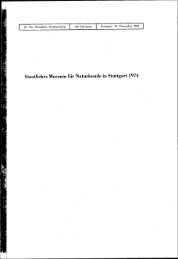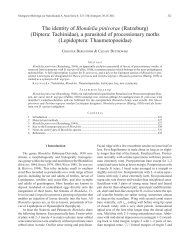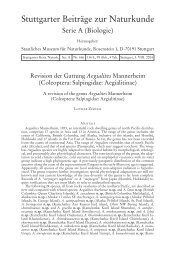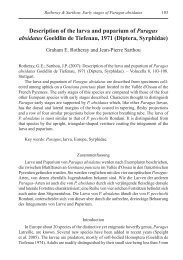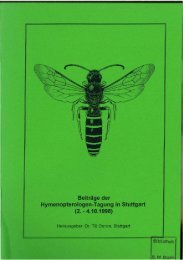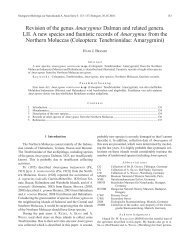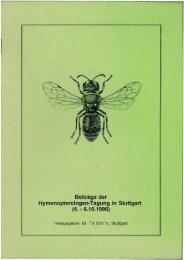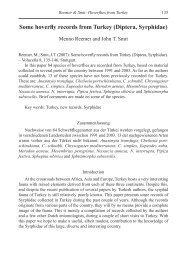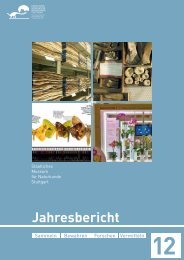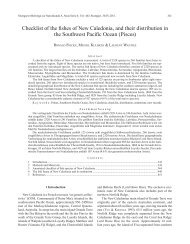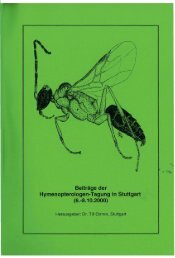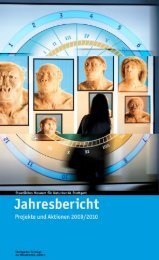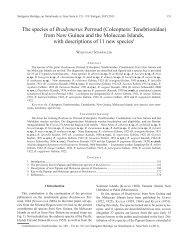Serie A (Biologie) - Staatliches Museum für Naturkunde Stuttgart
Serie A (Biologie) - Staatliches Museum für Naturkunde Stuttgart
Serie A (Biologie) - Staatliches Museum für Naturkunde Stuttgart
You also want an ePaper? Increase the reach of your titles
YUMPU automatically turns print PDFs into web optimized ePapers that Google loves.
52 stuttgarter beiträge zur naturkunde Ser. A, Nr. 694riorly), 5, 6, 7 with keel, keels with granules, internal intervals 1–4 on the elytral discflat, with fine punctation, without granules but somewhat wrinkled. Tibiae in bothsexes externally without distinct keels. Aedeagus see Fig. 117.Diagnosis: To be recognized by the broad pronotum without protruding anteriorcorners, by the structure of the elytra, and by the shape of the aedeagus.Bradymerus pertyi Gebien, 1921 from the Philippines has a somewhat similar structureof the elytra, but in this species the flat internal intervals bear some granules andonly the alternate intervals are keel-like, the pronotum has a different shape androugher punctation, and the aedeagus is different (Figs. 117, 124).Bradymerus malayicus n. sp. (Figs. 51, 114)Holotype (): W Malaysia, Pahang, Cameron Highlands, 30 km E Ipoh, Tanah Rata,1500 m, 22.–26.I.1999, leg. P. ČECHOVSKÝ, SMNS.Paratypes: Thailand, Chumphon Prov., Pha To, 1.–20.III.1996, leg. K. MAJER, 1 ex.SMNS. – Thailand, Chumphon Prov., Pha To, 14.III.–14.IV.1996, leg. P. PRU° DEK, 30 ex.CSBC, 8 ex. SMNS, 2 ex. HNHM. – India, Assam, U. Dihing, Lakhimpur, 28.V.1921, leg. C.F. C. BEESON, 1 ex. BMNH.Etymology: Named after the Malayan Peninsula, where the holotype was collected.Description: Dorsal view see Fig. 51, dorsal side dark ferrugineous withoutmetallic shine, body length 6.0–6.5 mm. Genae not broader than eyes, frons withoutdistinct supraorbital keels. Last 5 antennomeres forming a club. Anterior corners ofpronotum not protruding, lateral margin without distinct crenulation but sinuated,pronotal disc with fine and separate punctation and without medial impression, betweenpunctures without granules. Elytral intervals slightly convex, without keelsand without granules. Tibiae in both sexes externally without distinct keels. Aedeagussee Fig. 114.Diagnosis: To be recognized by the 5-segmented antennal club, by convex elytralintervals without keels and granules, by the flat and broad pronotum with fineand separate punctation and without protruding anterior corners, by unmodifiedposterior tibiae in males and by the shape of the aedeagus. A similar elytral structurehas Bradymerus incostatus Gebien, 1914 from the Sunda Island and W Malaysia, andB. kanchenjungicus n. sp. from Nepal. B. incostatus, however, has a different shape ofthe pronotum with distinctly protruding anterior corners and modified posteriortibiae in males, and B. kanchenjungicus n. sp. has also a different shape of the pronotumwidest before the middle and with denser confluent punctation (in B. malayicusn. sp. pronotum widest in the middle and with fine and separate punctation). See alsoB. pseudomalayicus n. sp. from the same area.Bradymerus maramagicus n. sp. (Figs. 53, 118)Holotype (): Philippines, Mindanao, 30 km W Maramag, 1600 m, 28.–30.XII.1990, leg.L. BOLM, SMNS.Etymology: Named after the village Maramag, in whose vicinity the holotype was collected.Description: Dorsal view see Fig. 53, dorsal side blackish without metallicshine, body length 7.2 mm. Genae not broader than eyes, frons without distinctsupraorbital keels, with deep supraorbital furrows. Last 5 antennomeres forming aclub. Anterior corners of pronotum distinctly protruding, lateral margin withoutdistinct crenulation, pronotal disc with distinct and sometimes confluent punctationand without medial impression, between punctures with indistinct granules. Elytral



